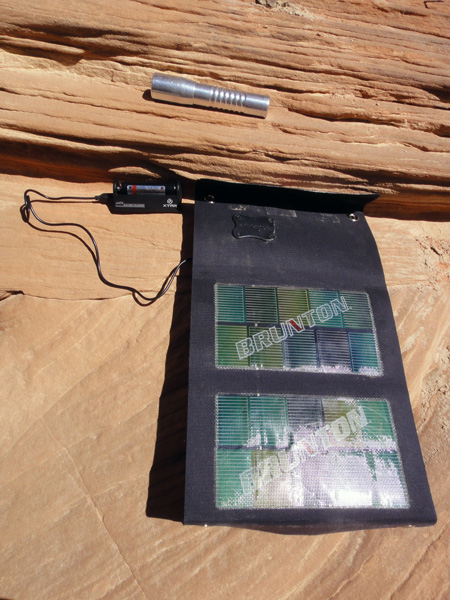Carbon2010
Newly Enlightened
- Joined
- Nov 4, 2009
- Messages
- 51
Some ideas I have been trying to sort through.
I'm looking to construct a small solar light for when we go camping. As much spread as possible. I have selected a few components already - more so because it's what I have on hand.
-12v 2W solar panel (used to trickle charge a car battery- 2 available)
-2 3W cool white Luxdrive crees.
-(1)Source of power
-Lm317 chipset for current regulation
-Various resistors/case/wire/Ect.
(1) I have a few options here. I'm looking for something reasonably bright but with at least 6 hours run time. Options are:
-3 hybrid NiMH 9V batteries
-1 3.6V 4500MaH NiMA battery pack (gutted from an old box)
-Your personal recommendations
Now if you guys can give me an idea on how to go about this that would be great. The basic idea I have now is the panel is fed into a simple current regulation circuit using the LM317. Using C10 i'll select the correct resistor, although this doesn't take care of overcharging, just regulation (I think - please let me know otherwise)
The LEDS simply attach to the Power option I choose. Panels charge the battery - Leds use the power.
If anyone has a better idea PLEASE post it up. I would love the feedback.
Thank you!
I'm looking to construct a small solar light for when we go camping. As much spread as possible. I have selected a few components already - more so because it's what I have on hand.
-12v 2W solar panel (used to trickle charge a car battery- 2 available)
-2 3W cool white Luxdrive crees.
-(1)Source of power
-Lm317 chipset for current regulation
-Various resistors/case/wire/Ect.
(1) I have a few options here. I'm looking for something reasonably bright but with at least 6 hours run time. Options are:
-3 hybrid NiMH 9V batteries
-1 3.6V 4500MaH NiMA battery pack (gutted from an old box)
-Your personal recommendations
Now if you guys can give me an idea on how to go about this that would be great. The basic idea I have now is the panel is fed into a simple current regulation circuit using the LM317. Using C10 i'll select the correct resistor, although this doesn't take care of overcharging, just regulation (I think - please let me know otherwise)
The LEDS simply attach to the Power option I choose. Panels charge the battery - Leds use the power.
If anyone has a better idea PLEASE post it up. I would love the feedback.
Thank you!





 bridge both ends of the potentiometer to a switch. The device will shutdown when the switch closes the circuit. The switch will pass virtually no current so you don't have to worry about insulating it. :hahaha::tinhat:
bridge both ends of the potentiometer to a switch. The device will shutdown when the switch closes the circuit. The switch will pass virtually no current so you don't have to worry about insulating it. :hahaha::tinhat: easy to use, :twothumbs very tolerant of noobish charge/discharging practices, and relatively safer than li-ion. Why 3.2AH? Because its cheaper than 2.3AH and it is impossible to predict if you may need it on "high" sometime in the future. Yeah it weighs 3 pounds but hey, it does what you want when you want it to.
easy to use, :twothumbs very tolerant of noobish charge/discharging practices, and relatively safer than li-ion. Why 3.2AH? Because its cheaper than 2.3AH and it is impossible to predict if you may need it on "high" sometime in the future. Yeah it weighs 3 pounds but hey, it does what you want when you want it to. 
 Driving two CREE XREs at 350ma [lets consider that as "high"
Driving two CREE XREs at 350ma [lets consider that as "high" This is on "high" of course, but suppose you are content with running the LEDs at only 175ma instead of 350ma, based on the CREE XRE datasheet they have a forward voltage of ~2.9V at 175ma [extrapolation] [2.9x2]+2=7.8V. With the buckpuck dimmed halfway, it will only draw about 120ma from a battery with its voltage around 12.8V. 0.12x6=0.72 or 720mah of its capacity consumed. Minimum battery size is rerated to 1.8AH.
This is on "high" of course, but suppose you are content with running the LEDs at only 175ma instead of 350ma, based on the CREE XRE datasheet they have a forward voltage of ~2.9V at 175ma [extrapolation] [2.9x2]+2=7.8V. With the buckpuck dimmed halfway, it will only draw about 120ma from a battery with its voltage around 12.8V. 0.12x6=0.72 or 720mah of its capacity consumed. Minimum battery size is rerated to 1.8AH.  You mentioned dimming towards the end of the second 6-hour run. If the solar cells weren't able to recharge it fully, your cells are going to be more depleted everytime a runtime is done.
You mentioned dimming towards the end of the second 6-hour run. If the solar cells weren't able to recharge it fully, your cells are going to be more depleted everytime a runtime is done.  Whether this is so is contestable, especially since no voltage reading [or better yet, voltage reading under load] is provided.:thinking:
Whether this is so is contestable, especially since no voltage reading [or better yet, voltage reading under load] is provided.:thinking: